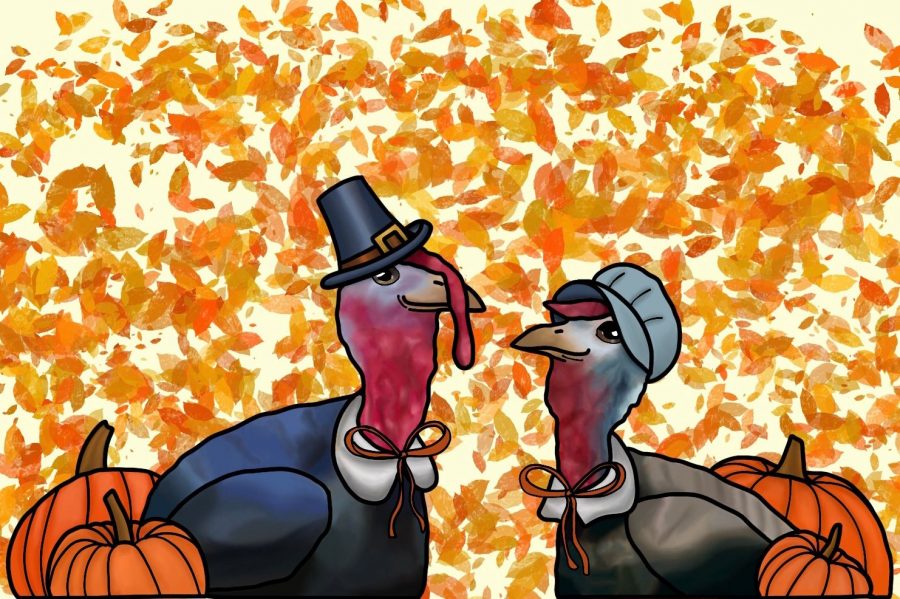Thanksgiving: The Beloved American Holiday With A Devastating History
December 3, 2021
Oh, November — the month of autumn leaves, Pumpkin Spice Frappuccinos, and
turtlenecks. For many, there are holidays to look forward to. One of these is Thanksgiving. Students often share about the endless amounts of food they have eaten and the reunions they have had with their families and friends.
Although it is widely celebrated amongst American families, the question has arisen about whether Thanksgiving is worth celebrating because of its history and lack of understanding about the origination of the holiday. In fact, many people feel that they were falsely educated on the history of Thanksgiving.
Elementary schools have taught about the holiday as a celebration of peace between settlers and Native Americans. Most remember that it began with the Pilgrims’ departure on the Mayflower. As they attempted to settle in Plymouth, the Pilgrim community struggled to survive the harsh winter and poor harvest. Native Americans helped the Pilgrim settlers, aiding them with harvest, which all led to a grand feast and expressions of gratitude. Yet is this story true?
Elijah Hansen, ‘23, says that “[Thanksgiving] was taught in a positive way, especially at school…but talking with my family about the different tradition, and what caused it, it’s definitely not positive. There’s a lot of dark facts surrounding the start of Thanksgiving.”
He later mentioned that Thanksgiving’s history is more accurately taught in high school.
“When you get into maybe eighth or ninth grade, then you either find out on your own or through school, depending on a teacher or project, about it. You usually end up finding out that what they told you earlier was not the truth,” Hansen said.
The history of Thanksgiving dates back to 1621, during the first settlement of the Pilgrims. Thanksgiving was not a moment of gratitude, but a party of “rejoicing” as described in Silverman’s This Land Is Their Land: The Wampanoag Indians, Plymouth Colony, and the Troubled History of Thanksgiving. There was some feasting involved, along with military training and target practice. The native Wampanoag people at the time overheard gunfire from their firing drills and arrived at the event unexpectedly, as they assumed that the settlers were under attack and needed aid. After a series of misunderstandings and suspicions, the two groups reluctantly spent several days together.
Relations between the native Wampanoag people and the settlers only worsened. This pattern of “rejoicing” only repeated after the defeat of the Wampanoag people. One particular Thanksgiving celebration occurred after King Philip’s War when the sachem Metacom of the Wampanoag people was viciously killed by Pilgrim militias. The Wampanoag people additionally suffered from the foreign pathogens and diseases that settlers had brought, as well as enslavement by settlers.
Atrocities toward indigenous people did not end with Thanksgiving. Indigenous people still face many hardships within the United States.
There are still violations against rights to land, violence against Indigenous women, and a lack of accurate representation of Indigenous people and their history. Many Native American tribes and communities consider Thanksgiving to be the beginning of the hardship, oppression and genocide that Indigenous people have faced. Some even refer to Thanksgiving Day as the National Day of Mourning.
According to the United American Indians of New England, “Thanksgiving day is a reminder of the genocide of millions of Native people, the theft of Native lands and the relentless assault on Native culture. Participants in National Day of Mourning honor Native ancestors and the struggles of Native peoples to survive today. It is a day of remembrance and spiritual connection as well as a protest of the racism and oppression which Native Americans continue to experience.”
Given the experience of Native Americans, how can non-Native people approach Thanksgiving with better understanding and respect?
While the majority of Americans celebrate it for the food, it is also important to acknowledge the ways people can support Indigenous creators and communities outside of Thanksgiving. Buy plants from Indigenous growers and invest money in Indigenous business owners and organizations.
It’s important for students to inform themselves about the issues that Native people continue to face, such as the Line 3 Pipeline and missing and murdered Indigenous women. Educate others about Indigenous history and combat stereotypes when they are present. These are all values that the Minnetonka community can apply to make a safer and more respectful environment for all students.






























